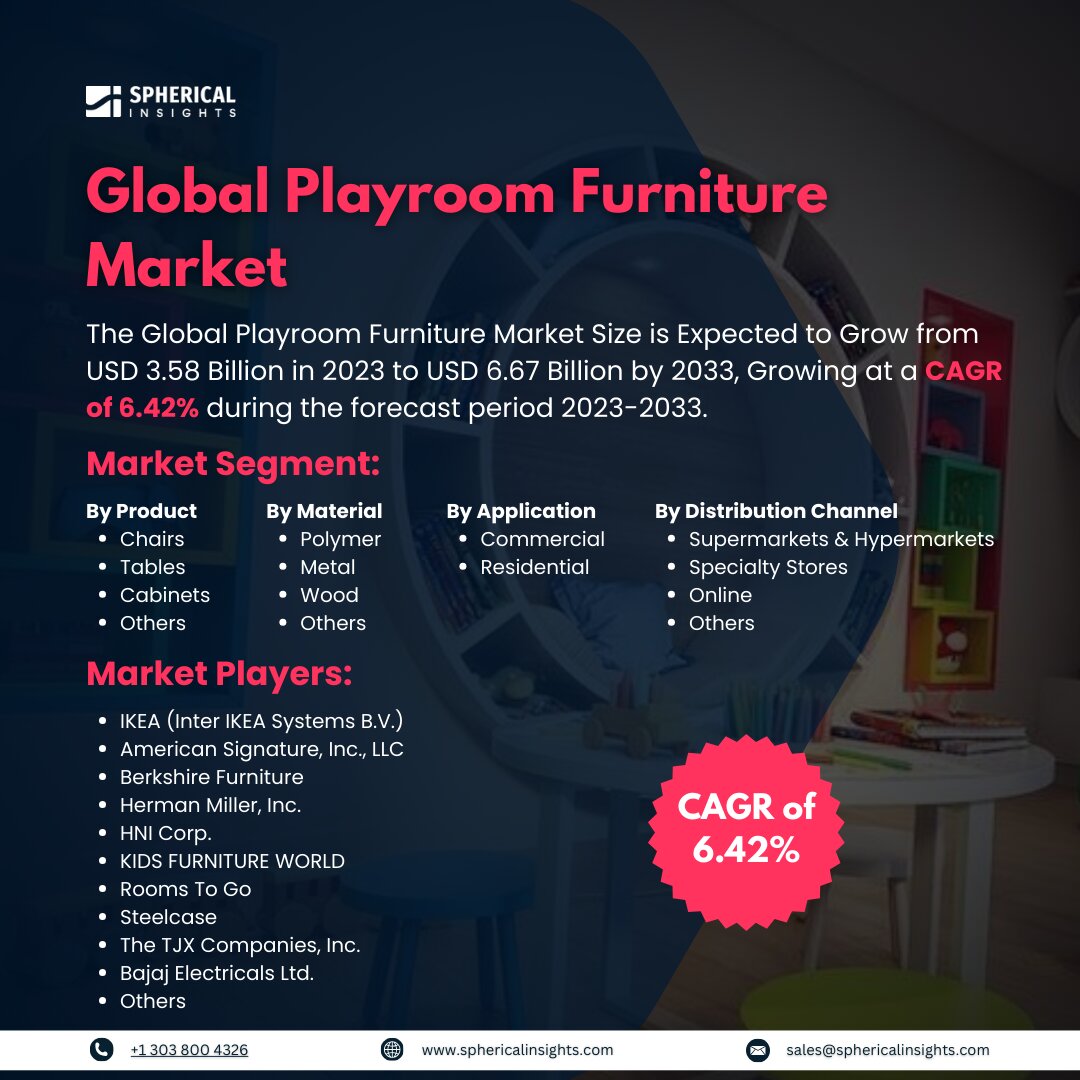Global Playroom Furniture Market Size to Worth USD 6.67 Billion by 2033
According to a research report published by Spherical Insights & Consulting, the Global Playroom Furniture Market Size is Expected to Grow from USD 3.58 Billion in 2023 to USD 6.67 Billion by 2033, Growing at a CAGR of 6.42% during the forecast period 2023-2033.
Browse key industry insights spread across 215 pages with 110 Market data tables and figures & charts from the report on the Global Playroom Furniture Market Size, Share, and COVID-19 Impact Analysis, By Product (Chairs, Tables, Cabinets, and Others), By Material (Polymer, Metal, Wood, and Others), By Application (Commercial and Residential), By Distribution Channel (Supermarkets & Hypermarkets, Specialty Stores, Online, and Others), and By Region (North America, Europe, Asia-Pacific, Latin America, Middle East, and Africa), Analysis and Forecast 2023 – 2033.
Playroom furniture is meant to fit into a specific pattern that should keep the child occupied. In the contemporary world, parents are becoming increasingly aware of several methods that are crucial to a baby's development. To give kids a fun and instructive atmosphere, they are implementing smart children's furniture. Increased availability of both domestic and foreign brands in various regions, growing awareness of the products' significance in children's developmental process, growing globalization, which necessitates the need for indoor playroom space, and rising disposable incomes are the main drivers of this industry's predicted growth. Demand for this market is expected to grow as a result of trends such as a greater emphasis on children's early development, a greater propensity to use products made from eco-friendly and sustainably sourced materials, an improved response to daycare services, and an increase in the number of commercial crèche organizations. However, the playroom furniture market may be hampered by the demand for sustainable production methods and environmentally friendly materials.
The chairs segment is expected to hold the largest market share of the global playroom furniture market through the forecast period.
Based on the product, the playroom furniture market is categorized into chairs, tables, cabinets, and others. Among these, the chairs segment is expected to hold the largest market share of the global playroom furniture market through the forecast period. Chairs serve a variety of purposes in a playroom, including reading, writing, playing games, and fostering social interaction. From children to older kids, there are chairs in a range of sizes and styles to fit different age groups. This flexibility aids in accommodating a wide range of age-specific needs and preferences. Chairs that encourage healthy sitting patterns and lower the risk of discomfort and injury are anticipated to be in high demand as ergonomics and child safety become more important.
The wood segment is predicted to hold a significant market share in the global playroom furniture market over the projected timeframe.
Based on the material, the playroom furniture market is classified into polymer, metal, wood, and others. Among these, the wood segment is predicted to hold a significant market share in the global playroom furniture market over the projected timeframe. The primary factors driving the segment's supremacy are its longevity, safety, and aesthetic appeal. Wood is regarded as one of the safest substitutes for other synthetic materials used to make playroom furniture, in contrast to those made with potentially dangerous substances and other components. Parents searching for individualized pieces for their kids' playrooms will find wood intriguing since it permits intricate artisanship and customization, and it can be crafted into distinctive designs, expanded carvings, and specific sizes.
The residential segment is anticipated to hold the highest market share of the global playroom furniture market through the projected period.
Based on the application, the playroom furniture market is classified into commercial and residential. Among these, the residential segment is anticipated to hold the highest market share of the global playroom furniture market through the projected period. Rising levels of disposable income and growing demand for child-specific space in residences are driving this segment's rise. The residential market, which offers home furnishings and particular spaces for purchasers' children, is expanding due to rising real estate in developing nations. The segment's growth is also being driven by shifting lifestyle patterns, a greater emphasis on indoor activities at home, and a growing focus on designing useful and entertaining areas for kids within the house.
The supermarkets & hypermarkets segment is estimated to hold the highest market share of the global playroom furniture market through the forecast period.
Based on the distribution channel, the playroom furniture market is divided into supermarkets & hypermarkets, specialty stores, online, and others. Among these, the supermarkets & hypermarkets segment is estimated to hold the highest market share of the global playroom furniture market through the forecast period. Since it gives the company more brand visibility, the major players in the industry prefer to concentrate on this distribution setting. Those brands have a better chance of selling at the entrances of well-known supermarkets and hypermarkets with high foot traffic. Additionally, consumers, particularly parents, prefer to shop offline since they can inspect the products in person and assess their quality, materials, and suitability for their particular needs.
North America is expected to hold the largest share of the playroom furniture market through the forecast period.
North America is expected to hold the largest share of the playroom furniture market through the forecast period. The development in consumer disposable income, the increasing demand for space specifically for children, an abundance of product offerings from international as well as local market players, the convenience of access via online portals, and other factors are the main drivers of this industry. Many businesses and parents prefer to see the products before purchasing, thus having multiple specialty stores with well-known brands increases client engagement.
Asia Pacific is predicted to grow at the fastest CAGR of the playroom furniture market over the forecast period. Rising infrastructure development, rising per capita income, and expanding parental understanding of early childhood development are the key drivers of the expansion. The demand for playroom furniture is also being driven by rapid urbanization and population growth. In addition, when the economy grows, more infrastructure is built, which reduces the number of playgrounds and outdoor play areas and increases market expansion in the area. Furthermore, it is anticipated that the increasing acceptance of e-commerce platforms and online buying will spur regional expansion.
Competitive Analysis
Major key players in the playroom furniture market include IKEA (Inter IKEA Systems B.V.), American Signature, Inc., LLC, Berkshire Furniture, Herman Miller, Inc., HNI Corp., KIDS FURNITURE WORLD, Rooms To Go, Steelcase, The TJX Companies, Inc., Bajaj Electricals Ltd., WILLIAMS-SONOMA INC., Ashley Global Retail, and others.
Recent Developments
- In January 2024, WILLIAMS-SONOMA, INC.'s portfolio brand Pottery Barn Kids announced its first partnership with AERIN, a well-known luxury lifestyle brand. The collection was introduced by the brand through POTTERY BARN KIDS and is the only one available in the children's home furnishings market.
Key Target Audience
- Market Players
- Investors
- End-users
- Government Authorities
- Consulting And Research Firm
- Venture capitalists
- Value-Added Resellers (VARs)
Market Segment
This study forecasts revenue at global, regional, and country levels from 2023 to 2033. Spherical Insights has segmented the playroom furniture market based on the below-mentioned segments:
Global Playroom Furniture Market, By Product
- Chairs
- Tables
- Cabinets
- Others
Global Playroom Furniture Market, By Material
- Polymer
- Metal
- Wood
- Others
Global Playroom Furniture Market, By Application
Global Playroom Furniture Market, By Distribution Channel
- Supermarkets & Hypermarkets
- Specialty Stores
- Online
- Others
Global Playroom Furniture Market, By Regional Analysis
- North America
- Europe
- Germany
- UK
- France
- Italy
- Spain
- Russia
- Rest of Europe
- Asia Pacific
- China
- Japan
- India
- South Korea
- Australia
- Rest of Asia Pacific
- South America
- Brazil
- Argentina
- Rest of South America
- Middle East & Africa
- UAE
- Saudi Arabia
- Qatar
- South Africa
- Rest of the Middle East & Africa



